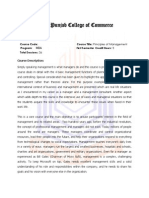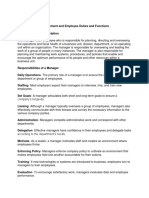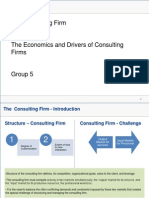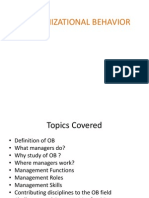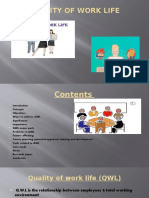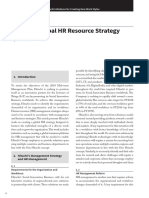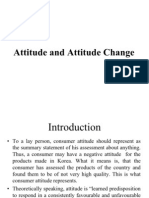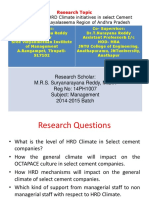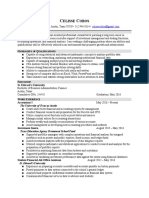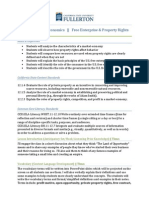0 ratings0% found this document useful (0 votes)
567 viewsFactors Influencing Working and Learning
Factors Influencing Working and Learning
Uploaded by
snreddy85The document discusses how globalization, technology, demographic changes and economic forces are transforming businesses and requiring companies to address these issues through training. It states that companies must focus on developing their intangible assets like human capital, customer relationships, and intellectual property in order to remain competitive. It also emphasizes the importance of training and development programs in helping companies attract, retain and develop talent, support their business strategies, and drive customer-focused excellence.
Copyright:
© All Rights Reserved
Available Formats
Download as PPTX, PDF, TXT or read online from Scribd
Factors Influencing Working and Learning
Factors Influencing Working and Learning
Uploaded by
snreddy850 ratings0% found this document useful (0 votes)
567 views18 pagesThe document discusses how globalization, technology, demographic changes and economic forces are transforming businesses and requiring companies to address these issues through training. It states that companies must focus on developing their intangible assets like human capital, customer relationships, and intellectual property in order to remain competitive. It also emphasizes the importance of training and development programs in helping companies attract, retain and develop talent, support their business strategies, and drive customer-focused excellence.
Original Description:
hi
Copyright
© © All Rights Reserved
Available Formats
PPTX, PDF, TXT or read online from Scribd
Share this document
Did you find this document useful?
Is this content inappropriate?
The document discusses how globalization, technology, demographic changes and economic forces are transforming businesses and requiring companies to address these issues through training. It states that companies must focus on developing their intangible assets like human capital, customer relationships, and intellectual property in order to remain competitive. It also emphasizes the importance of training and development programs in helping companies attract, retain and develop talent, support their business strategies, and drive customer-focused excellence.
Copyright:
© All Rights Reserved
Available Formats
Download as PPTX, PDF, TXT or read online from Scribd
Download as pptx, pdf, or txt
0 ratings0% found this document useful (0 votes)
567 views18 pagesFactors Influencing Working and Learning
Factors Influencing Working and Learning
Uploaded by
snreddy85The document discusses how globalization, technology, demographic changes and economic forces are transforming businesses and requiring companies to address these issues through training. It states that companies must focus on developing their intangible assets like human capital, customer relationships, and intellectual property in order to remain competitive. It also emphasizes the importance of training and development programs in helping companies attract, retain and develop talent, support their business strategies, and drive customer-focused excellence.
Copyright:
© All Rights Reserved
Available Formats
Download as PPTX, PDF, TXT or read online from Scribd
Download as pptx, pdf, or txt
You are on page 1of 18
Globalization of business, demographic
changes, new technologies and economic
changes are influencing individuals,
communities, business and society. To
survive companies must address these forces
with training.
Globalization
Need for leadership
Increased value places on intangible assets and
human capital
Focus on link to business strategy
Attracting and retraining talent
Customer service and quality emphasis
Changing demographics and diversity of work
force
New technology
High-performance models of work sysytems
Economics
Entering international markets
P & G is targeting feminine hygiene products to new
markets such as Brazil
The demands for steel in china, India and brazil is
expected to grow at three tines the U.S. rate.
Competition for local management work force
Cross cultural training
The aging workforce
Uncomfortable working environment created
by the managers
To successfully manage the global economy
Identification new talent and potential
managers
Eg: IKEA, the swedish based home furnishing
retailer that has its U.S. head quarters in
pennyylvania. One program requires new
managers to go through a rotation that
involves working in every area of the store.
Managers are also required to compete in a
self-paced, e-learning program that
encourages them to interact with colleagues.
A companys value includes three types
Financial assets ( cash & securities)
Physical Assets (Property, plant , equipment)
Intangible Assets
Intangible Assets consists of
Human Capital
Customer Capital
Social Capital
Intellectual capital
Human Capital refers to the sum of the
attributes, life experiences, knowledge,
inventories, energy and enthusiasm that the
companys employees invest in their work.
Intellectual capital refers to the codifies
knowledge that exist in a company.
Social Capital refers to relationship in the
company.
Customer capital refers to the value of
relationships with persons or other organizations
outside the company for accomplishing the goals
of the company.
A study by ASTD
Southwest Airlines
Knowledge workers
Empowerment
Change
A Learning organization
The intangible assets and human capital play
an important role in a company's
competitiveness, managers are beginning to
see a more important role for T&D as a
means to support a companys business
strategy i.e., its plan for meeting broad goals
such as profitability, market share and
quality.
Ex: IBM has adopter an on-demand business
strategy that requires the company to more quickly
respond to customers need and help them do the
same for their clients.
Retention is and important part of talent
management.
Talented employees are looking for growth
and a career path.
T&D is a key to attract and retain talented
employees
Companies customers judge quality and
performance.
Customer-driven excellence includes
understanding what the customer wants and
anticipating future needs.
Diversified work force,
Skill deficiencies and
Changes in work place.
Technological advancements
The following methods increase employees
responsibility and control is
Work teams
Cross training
Virtual teams
Work teams involve employees with various
skills who interact to assemble a product or
provide a service.
Cross training refers to training employees in a
wide range of skills so they can fill any of the
roles needed to be performed in a team
Virtual teams refer to teams that are separated
by time, geographical distance, culture and /or
organizational boundaries and that are rely
almost exclusively on technology to interact
and complete their projects.
You might also like
- (English) Navigos Group - Talent Guide 2024Document180 pages(English) Navigos Group - Talent Guide 2024vananhle08No ratings yet
- Grade 8 Teacher Guide For EnglishDocument68 pagesGrade 8 Teacher Guide For EnglishNoël Perera90% (40)
- Case Study Darcy Gallagher Role Play: Performance Coaching DiscussionDocument5 pagesCase Study Darcy Gallagher Role Play: Performance Coaching Discussionlara masriNo ratings yet
- Management Course OutlineDocument3 pagesManagement Course OutlineAsadvirkNo ratings yet
- Jahangirnagar University: A Case Study On Acceleration Pools at PepsicoDocument5 pagesJahangirnagar University: A Case Study On Acceleration Pools at PepsicoMoushumi PriyangkaNo ratings yet
- Case Study-Organisational Culture at Southwest AirlinesDocument2 pagesCase Study-Organisational Culture at Southwest Airlinessnreddy850% (2)
- Labour Laws - PPTDocument42 pagesLabour Laws - PPTsnreddy85No ratings yet
- Introduction: Advancing To Present ResearchDocument6 pagesIntroduction: Advancing To Present ResearchDozdiNo ratings yet
- Daily Lesson PlanDocument4 pagesDaily Lesson PlanJacq Hereirra100% (3)
- Recruitment & SelectionDocument23 pagesRecruitment & SelectionShehnaz KhanNo ratings yet
- What Is Corporate Governance?: The System by Which Companies Are 'Document54 pagesWhat Is Corporate Governance?: The System by Which Companies Are 'MaisamNo ratings yet
- Lect 10 Leading (Motivation)Document36 pagesLect 10 Leading (Motivation)Tayyab Ahmed ChughtaiNo ratings yet
- Organizational ChangeDocument34 pagesOrganizational ChangeAmit KumarNo ratings yet
- Strategic Leadership Knowledge ManagementDocument14 pagesStrategic Leadership Knowledge ManagementAlthea mayNo ratings yet
- "Yes, We Have An Anti-bullyingPolicy, But " HR Professionals'Understandings and Experiences Withworkplace Bullying PolicyDocument22 pages"Yes, We Have An Anti-bullyingPolicy, But " HR Professionals'Understandings and Experiences Withworkplace Bullying PolicySenthamizh SankarNo ratings yet
- 08 PPT Mentoring Programs - FinalDocument18 pages08 PPT Mentoring Programs - FinalKrishna SinghNo ratings yet
- Organizational BehaviorDocument22 pagesOrganizational BehaviorPeter Wafom100% (1)
- CQHRM U15 - Knowledge Management - English - V1Document24 pagesCQHRM U15 - Knowledge Management - English - V1Madilka FernandoNo ratings yet
- Masters' Union: - Mentee HandbookDocument2 pagesMasters' Union: - Mentee HandbookLakshay SainiNo ratings yet
- People ManagementDocument24 pagesPeople ManagementMyFood OrTravel100% (1)
- Building Healthy RelationshipsDocument65 pagesBuilding Healthy Relationshipsjoy cristalNo ratings yet
- Chapter Ten: Enhancing Teamwork Within The GroupDocument12 pagesChapter Ten: Enhancing Teamwork Within The GroupsyazaainaasafirahNo ratings yet
- Chapter 1 - Introduction To ManagmentDocument14 pagesChapter 1 - Introduction To ManagmentsamNo ratings yet
- Unit 10 Strategic Human Resource ManagemDocument16 pagesUnit 10 Strategic Human Resource ManagemAngelo VillalobosNo ratings yet
- MBM Competency Frameworks Soft Skills DAS 14-06-16Document16 pagesMBM Competency Frameworks Soft Skills DAS 14-06-16hrhvdyNo ratings yet
- Unit 2 Conceptual Framework of Organizational DevelopmentDocument48 pagesUnit 2 Conceptual Framework of Organizational DevelopmentShiwangi Alind Tiwary100% (1)
- 02 MotivationDocument25 pages02 MotivationRaj KumarNo ratings yet
- Management and Employee Duties and FunctionsDocument3 pagesManagement and Employee Duties and FunctionsRia Paula PacuanNo ratings yet
- Leadership Crossword PuzzleDocument2 pagesLeadership Crossword PuzzleIlya Yasnorina Ilyas100% (1)
- Basics of Management ConsultingDocument9 pagesBasics of Management ConsultingTarun AjwaniNo ratings yet
- On Organistaion BehaviourDocument31 pagesOn Organistaion Behaviourvanishachhabra5008100% (1)
- Quality of Work Life Final Pptankita BarkhaDocument28 pagesQuality of Work Life Final Pptankita BarkhadollyguptaNo ratings yet
- Job SecurityDocument46 pagesJob SecurityHoly TranNo ratings yet
- Mastering Advanced Integrated Talent Management:: Dr. Anna Tavis, PH.DDocument3 pagesMastering Advanced Integrated Talent Management:: Dr. Anna Tavis, PH.Daasimshaikh111No ratings yet
- Introduction and Evolution of MGT TheoryDocument169 pagesIntroduction and Evolution of MGT TheorySimon Muteke100% (2)
- Foundation of IS in Business PDFDocument26 pagesFoundation of IS in Business PDFJill SulitNo ratings yet
- Culture Design Canvas by Gustavo Razzetti 33 - X 47 ColorDocument1 pageCulture Design Canvas by Gustavo Razzetti 33 - X 47 ColorMelissa Cinara DietrichNo ratings yet
- 3 Unit 1 Approaches To SHRMDocument12 pages3 Unit 1 Approaches To SHRMLavesh SethiaNo ratings yet
- Leadership in OrganizationsDocument19 pagesLeadership in OrganizationsDBNo ratings yet
- HR FaqsDocument40 pagesHR FaqsPrakash ParidaNo ratings yet
- Hitachi's Global HR Resource Strategy: Kiyoshi TatedaDocument6 pagesHitachi's Global HR Resource Strategy: Kiyoshi TatedaManish Mehra100% (1)
- PPTDocument17 pagesPPTJeyarajasekar Ttr100% (1)
- Module 3 - Impact of Corporate Restructuring On HRDocument23 pagesModule 3 - Impact of Corporate Restructuring On HRGangadhar MamadapurNo ratings yet
- Power and Politics: Bases, Tactics and BehaviorsDocument25 pagesPower and Politics: Bases, Tactics and BehaviorsHumair JafriNo ratings yet
- Attitude and Attitude ChangeDocument18 pagesAttitude and Attitude ChangeRajeev SethNo ratings yet
- Management by Objectives (MBO) : Shweta Gersappa Sushena Sharma Shruti SiagDocument12 pagesManagement by Objectives (MBO) : Shweta Gersappa Sushena Sharma Shruti SiagSushena SharmaNo ratings yet
- Organisation Development Notes Unit-1Document2 pagesOrganisation Development Notes Unit-1Sreedharan Harshini33% (3)
- Decision Making and Problem Solving (UPSC Previous Years' Questions 2011 To 2019)Document6 pagesDecision Making and Problem Solving (UPSC Previous Years' Questions 2011 To 2019)Sherlock HolmesNo ratings yet
- Workflow HRDocument26 pagesWorkflow HRPatty NicolasNo ratings yet
- An Overview of OD InterventionsDocument13 pagesAn Overview of OD InterventionsNitika Puniani SahniNo ratings yet
- E Ch6 Mathis Job AnalysisDocument64 pagesE Ch6 Mathis Job AnalysisNatik Bi IllahNo ratings yet
- IHRM: Sustaining International Business Operations: Chapter No. 3Document19 pagesIHRM: Sustaining International Business Operations: Chapter No. 3rajulramiNo ratings yet
- Time Management For NGOs - FirstpirationDocument11 pagesTime Management For NGOs - FirstpirationIjeoma ChiemelaNo ratings yet
- IHRM Module 2Document32 pagesIHRM Module 2Pavithra SrinivasNo ratings yet
- Strategic Course OutlineDocument2 pagesStrategic Course OutlineKetema AsfawNo ratings yet
- Assessing HR Programmes:: UNIT-06 Creating HR ScorecardDocument9 pagesAssessing HR Programmes:: UNIT-06 Creating HR ScorecardAppu SpecialNo ratings yet
- Decision Making and Problem Solving NotesDocument3 pagesDecision Making and Problem Solving NotesJoyce100% (1)
- Line ManagerDocument76 pagesLine ManagerSubhasis PadhyNo ratings yet
- Department at I OnDocument28 pagesDepartment at I Onmikhil.muraliNo ratings yet
- C6-Decision MakingDocument43 pagesC6-Decision MakingAziz AnisahNo ratings yet
- NEGOTIATION - Readings, Exercises, and Cases - 4th EditionDocument32 pagesNEGOTIATION - Readings, Exercises, and Cases - 4th EditionSalus Hernando TiedraNo ratings yet
- Motivation and Motivational Theory Theories (Industrial Management)Document12 pagesMotivation and Motivational Theory Theories (Industrial Management)Fayeq Al Amin100% (8)
- ConciliationDocument10 pagesConciliationsnreddy85No ratings yet
- Chapter 19 PDFDocument34 pagesChapter 19 PDFsnreddy85No ratings yet
- By: Dadasaheb AnuseDocument26 pagesBy: Dadasaheb Anusesnreddy85No ratings yet
- Unit - One MEDocument13 pagesUnit - One MEsnreddy85No ratings yet
- Dispute Resolution Methods & Machinery: M140039MS Ajay Ram K PDocument27 pagesDispute Resolution Methods & Machinery: M140039MS Ajay Ram K Psnreddy85No ratings yet
- Obhrm Unit VDocument17 pagesObhrm Unit Vsnreddy85No ratings yet
- Human Resource Management: II Semester: MBADocument2 pagesHuman Resource Management: II Semester: MBAsnreddy85No ratings yet
- Employee Legislation QP 2016-2018Document2 pagesEmployee Legislation QP 2016-2018snreddy85No ratings yet
- RRMDocument8 pagesRRMsnreddy85No ratings yet
- Define "Business Intelligence" and "Support System" With Examples. Explain Business Intelligence IssuesDocument2 pagesDefine "Business Intelligence" and "Support System" With Examples. Explain Business Intelligence Issuessnreddy85No ratings yet
- Employee Counseling in OrganizationDocument6 pagesEmployee Counseling in Organizationsnreddy85100% (1)
- Compensation Management CASE STUDYDocument2 pagesCompensation Management CASE STUDYsnreddy8567% (3)
- Meaningful Job-"The State of Happiness in The Mind"Document1 pageMeaningful Job-"The State of Happiness in The Mind"snreddy85No ratings yet
- Generated by CamscannerDocument1 pageGenerated by Camscannersnreddy85No ratings yet
- Recruitment & Selection - Questionnaire Part-ADocument3 pagesRecruitment & Selection - Questionnaire Part-Asnreddy85No ratings yet
- 9 Juhi Ahuja 812 Research Communication MBA July 2012Document13 pages9 Juhi Ahuja 812 Research Communication MBA July 2012snreddy85No ratings yet
- Evolution of HRDDocument10 pagesEvolution of HRDsnreddy85No ratings yet
- HRM Case StudyDocument3 pagesHRM Case Studysnreddy8550% (2)
- Laziness To Read Leads To Poor Academic Performance - Kalvimalar - NewsDocument3 pagesLaziness To Read Leads To Poor Academic Performance - Kalvimalar - NewsSury GaneshNo ratings yet
- Academic 4Document160 pagesAcademic 4anthony aguirreNo ratings yet
- Presentation On Theme: "Ch. 1 Outline Managing in The New Competitive Landscape" - Presentation TranscriptDocument3 pagesPresentation On Theme: "Ch. 1 Outline Managing in The New Competitive Landscape" - Presentation TranscriptGenehye Paronia BernadezNo ratings yet
- Discipline Report: Harlem High School Columbia CountyDocument4 pagesDiscipline Report: Harlem High School Columbia CountyJeremy TurnageNo ratings yet
- Music - Week 2Document4 pagesMusic - Week 2Jeanne Pauline OabelNo ratings yet
- 11 Intro To Philo As v1.0Document21 pages11 Intro To Philo As v1.0Maria Virginia Fernandez50% (4)
- LP - A Nightmare Journey - Phrasal Verbs - Aysu CogurDocument6 pagesLP - A Nightmare Journey - Phrasal Verbs - Aysu CogurOmar BelazriNo ratings yet
- A3 Practical Problem-Solving SkillsDocument10 pagesA3 Practical Problem-Solving SkillsVijay KashettiNo ratings yet
- Mariachi GeneralDocument21 pagesMariachi GeneralJaimeNo ratings yet
- How To Prepare For Ed Tech InterviewsDocument49 pagesHow To Prepare For Ed Tech Interviewssunil tripathiNo ratings yet
- Risk Management HandbookDocument32 pagesRisk Management Handbookrambo7799100% (1)
- Borang Ulasan Video CritiqueDocument3 pagesBorang Ulasan Video Critiquemerlyn90No ratings yet
- Generating Leaders GE StyleDocument6 pagesGenerating Leaders GE StyleiloveyouphuongvyNo ratings yet
- Wk9Lec WK 9 Isi Kandungan MetodologiDocument18 pagesWk9Lec WK 9 Isi Kandungan MetodologiNoorleha Mohd YusoffNo ratings yet
- Internship AcknowledgementDocument34 pagesInternship AcknowledgementWaqas Ali KhanNo ratings yet
- San Fernando National High SchoolDocument3 pagesSan Fernando National High SchoolFlorita LagramaNo ratings yet
- Celisse Cobos Trs ResumeDocument2 pagesCelisse Cobos Trs Resumeapi-301798205No ratings yet
- Cobbgiftedservicesmanual2014 15Document40 pagesCobbgiftedservicesmanual2014 15api-299934038No ratings yet
- 1524Document68 pages1524Eugene TaoiNo ratings yet
- September 25 2015 Dunlap Invite Girls Varsity-1Document6 pagesSeptember 25 2015 Dunlap Invite Girls Varsity-1api-248185892No ratings yet
- Research RubricDocument1 pageResearch Rubricapi-250124834No ratings yet
- 4.5.2barcharts PictogramDocument4 pages4.5.2barcharts Pictogrammhussainarabi@gmail.comNo ratings yet
- Free Enterprise & Property Rights LessonDocument3 pagesFree Enterprise & Property Rights Lessonalihanson86No ratings yet
- Tugas Perorangan TeoriDocument8 pagesTugas Perorangan TeoriZorro HikariNo ratings yet
- EST Essay - December 2020Document7 pagesEST Essay - December 2020Mohammed AbdallahNo ratings yet
- The Causes of Culture ShockDocument2 pagesThe Causes of Culture Shockalumnodia070% (1)
- WLP q1w3 English 9 Coquilla Hadja Karen GDocument6 pagesWLP q1w3 English 9 Coquilla Hadja Karen GHADJA KAREN GALLARDONo ratings yet




